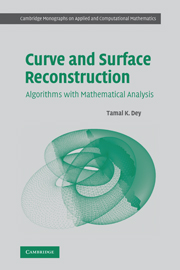1 - Basics
Published online by Cambridge University Press: 20 August 2009
Summary
Simply stated, the problem we study in this book is: how to approximate a shape from the coordinates of a given set of points from the shape. The set of points is called a point sample, or simply a sample of the shape. The specific shape that we will deal with are curves in two dimensions and surfaces in three dimensions. The problem is motivated by the availability of modern scanning devices that can generate a point sample from the surface of a geometric object. For example, a range scanner can provide the depth values of the sampled points on a surface from which the three-dimensional coordinates can be extracted. Advanced hand held laser scanners can scan a machine or a body part to provide a dense sample of the surfaces. A number of applications in computer-aided design, medical imaging, geographic data processing, and drug designs, to name a few, can take advantage of the scanning technology to produce samples and then compute a digital model of a geometric shape with reconstruction algorithms. Figure 1.1 shows such an example for a sample on a surface which is approximated by a triangulated surface interpolating the input points.
The reconstruction algorithms described in this book produce a piecewise linear approximation of the sampled curves and surfaces.
- Type
- Chapter
- Information
- Curve and Surface ReconstructionAlgorithms with Mathematical Analysis, pp. 1 - 25Publisher: Cambridge University PressPrint publication year: 2006



